|
|
DT Research DT302RP
A new, slimmer and lighter implementation of a rugged 10-inch high-performance Windows tablet designed for tough jobs in the field and everywhere else
by Conrad H. Blickenstorfer, August 2024
As a follow-up as well as a complement to their perennially successful DT301 Series of Windows tablets platform, DT Research released the new DT302RP that is slimmer, lighter, and more technologically up-to-date. The DT302RP is an attractive new design that, like the DT301 Series, is a rugged tool for the job, a tablet computer purpose-designed for serious work and use in all sorts of challenging environments.
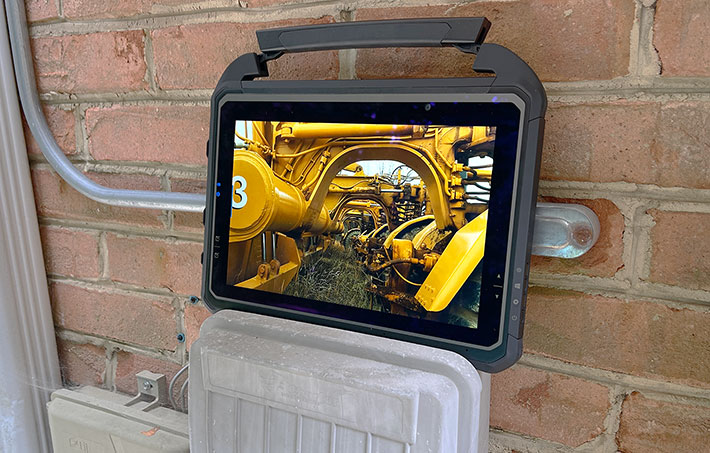
DT Research, which was founded in Silicon Valley, California, has decades' worth of experience in all sorts of information appliances, and that includes rugged mobile hardware and solutions for logistics, transportation, retail and hospitality, governments, education, and medical industries and more.
|
|
DT Research model
|
DT301Y
|
DT302RP
|
|
|
Size (inches)
|
11.00 x 7.80 x 0.86
|
10.71 x 7.70 x 0.79
|
|
|
Volume
|
73.8 cubic inches
|
65.1 cubic inches
|
|
|
Intel Processor
|
Tiger Lake (gen 11)
|
Raptor Lake (gen 13)
|
|
|
Weight
|
3.1 lbs.
|
3.0 lbs
|
|
|
Cooling
|
Fanless
|
Fanless
|
|
|
Display size (inches)
|
10.1 (1920 x 1200)
|
10.1 (1920 x 1200)
|
|
|
Luminance
|
1000 nits
|
800 nits
|
|
|
Main Battery capacity
|
61.6 watt-hours
|
44.5 watt-hours
|
|
|
Opt. Battery capacity
|
91.2 watt-hours
|
61.6 or 91.2 watt-hours
|
|
|
Battery consumption
|
6.47 whr/hour
|
7.57 whr/hour
|
|
|
Drop spec
|
4 feet
|
4 feet
|
|
|
Sealing
|
IP65
|
IP65
|
On the rugged tablet side, the company covers a wide size spectrum that includes Microsoft Windows-based models with 6, 8, 10.1, 11.6, 13.3 and 14-inch displays.
There's also an Android-based rugged tablet (the 10.1-inch DT303CI), there are specially equipped GNSS tablets with survey grade capabilities, there is a whole lineup of ANSI/AAMI ES60601-1 certified medical tablets, and that's in addition to POS and digital signage systems and a range of micro PCs.
The table to the right shows a comparison between two of the company's popular 10.1-inch 2-in-1 rugged Windows tablets. We reviewed the DT301Y a few months ago — a long-running and very versatile platform that's been kept updated over the years. The new DT302RP, which includes all the latest tech, is just as rugged, but looks and feels smaller and lighter than the DT301 though it's actually quite close in many specs.
A timeless tablet solution for work and business
Starting off with the review, let's take a closer look at the DT302RP tablet, what it looks like from upfront and from each side. It's instantly clear that this is an entirely different animal from iPads or tablets from Samsung or Lenovo or other consumer tablet makers. This is a rugged tablet, rugged from the ground up, and designed to provide the functionality and durability required by a serious tool for jobs in the field and any place where substantial computing power is needed away from the office and the safety of a desk or briefcase.
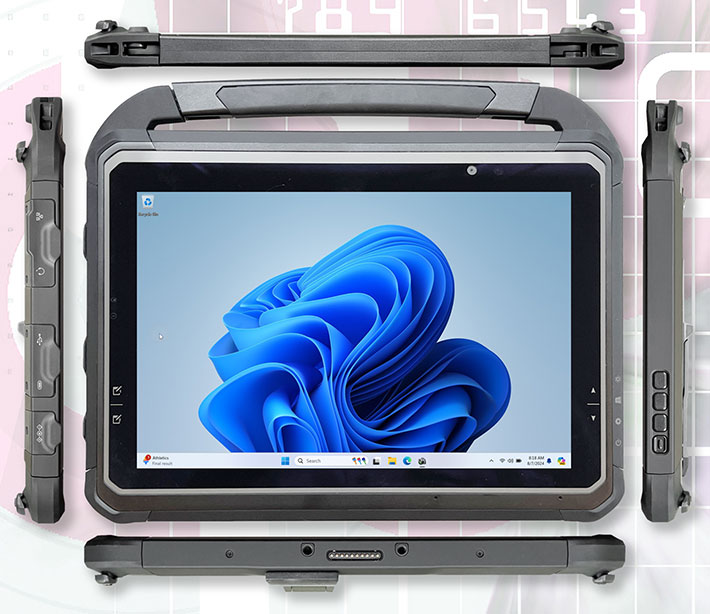
Given that this is a full-function Microsoft Windows personal computer with all the wired connectivity required of a modern PC, the DT302RP is a very compact design. Compared to the older but similar DT301 Series, the new tablet is slimmed down quite a bit. There are still the hefty protective bumpers that give rugged tablets the extra protection they need in the field. But here they are completely integrated into the design, even though they still bolt on and are easy to replace.
There's a power/sleep button on the right side, and a trio of hardware buttons bring up the Control Center screen, the Windows menu, and execute the "Security" modern day equivalent of the old alt-ctl-del. There are also four capacitive touch buttons integrated into the display bezel, two on the left and two on the right. A utility allows programming some of these buttons to whatever the job requires. Anything else is done onscreen.
Rugged tablets usually don't have a lot of onboard connectors because every opening to the vulnerable inside with all of its electronics is another area that needs to be sealed and protected. The DT302RP covers the basics with a single full-size USB 3.0 Type-A port, a reversible USB Type-C port, an RJ45 LAN jack, and a standard 3.5mm audio jack, all on the left side. There are docking contacts on the bottom, and there's a bolt-on carry handle on top.
What you won't find are fan cooling slots — the DT302RP doesn't have a (potentially noisy and troublesome) fan. Removing the heat of the high-performance electronics is done via clever thermal engineering.
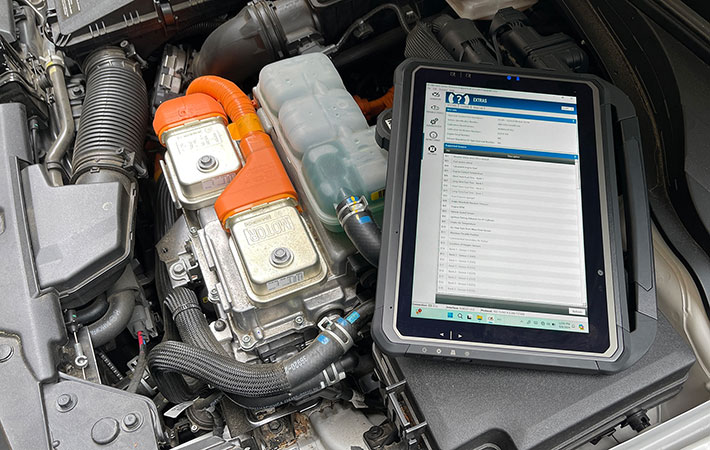
It's a 2-in-1 hybrid, and not just a tablet
Before getting into a discussion of the functional and performance aspects of the DT302RP tablet, here's how DT Research early on decided to make their tablets more than just tablets. Company president Dr. Daw Tsai was quoted as saying "Mobile tablets are fast becoming the 'go to' computing device for the military and other field jobs. But as the use of mobile tablets has risen, we saw that users need the flexibility to use tablets in a variety of settings. Our 2-in-1 ultra-rugged tablets can dynamically adapt to indoor and outdoor use, while remaining light and durable with our signature fully-integrated design."
That makes perfect sense, and it is also where the tablet market is going. Smartphones and, to a lesser extent, tablets have revolutionized the world to a degree that no one thought possible. But even with all this new mobility, when sitting down at a desk to do work, a keyboard may still be needed, and perhaps may always be needed. There are, of course, all sorts of wired or wireless keyboards that work with tablets, but nothing works as well as a keyboard that's specifically designed for use with your tablet. DT Research gave that much thought and created a simple keyboard solution that works very well. It uses magnets to quickly and easily snap the keyboard into place.
The pictures below shows DT Research's approach to the 2-in-1 concept, and how the configurations can be used. The tablet itself has a fixed-angle easel stand that can be used for the tablet alone or for the tablet with the keyboard. The easel doesn't doesn't have an adjustable viewing angle, but eliminates the clumsy top-heaviness of many other 2-in-1 solutions.
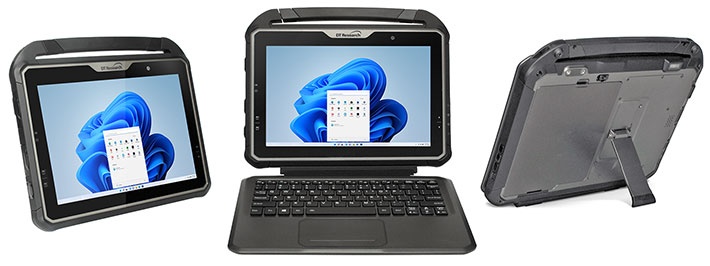
The detachable keyboard communicates via ten surface mount pins, making for a connection that's quicker and more reliable than Bluetooth or other wireless methods. The keyboard, which matches the tablet in materials, color and texture, has 82 keys with the overall look and feel of the slender Apple keyboard that has pretty much become the standard for modern keyboards, including 12 function keys. Touch typists will note, however, that the QWERTY letter layout is not quite full-scale. In general, we like to see the standard 100%-scale layout on any physical keyboard. Even two or three finger typists have muscle memory and can be thrown off when they keys aren't exactly where the brain thinks they should be.
The 2-in-1 concept — tablet/laptop functionality in one — isn't new. It goes back all the way to the very beginnings of pen computing and tablets in the late 1980s and early 1990s, over three decades ago. Early efforts didn't work well enough to catch on beyond certain niche markets, in part because the first tablet computers were big and heavy, and adding a keyboard for a 2-in-1 solution made them even more so. Then, in 2001, Microsoft launched their "Tablet PC" concept, first as pure tablets and then as convertible notebooks where you could flip the display around and make them into (thick and heavy) tablets. More recently, waver-thin keyboards that attach magnetically to consumer tablets have become popular. Those can work well, but generally aren't very practical for rugged industrial tablets.
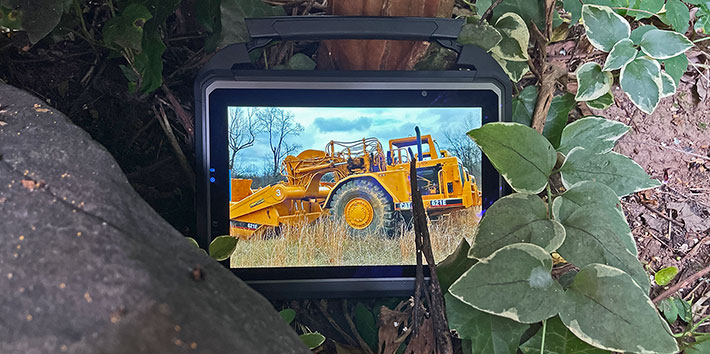
Design and construction
The DT302RP is the company's newest tablet platform. DT Research didn't aim to reinvent the (tablet) wheel with it, they just wanted to create a slimmed down tablet derivative of their DT301 platform for customers who need "the basics" — a handy, modern state-of-the-art high-performance workhorse. The DT302RP doesn't have all the options of the DT301 platform, but it's configurable enough to fill various types of deployments. As is, the company prides itself in its practice of "pre-integrating" modular hardware instead of offering functionality as "bolt-on" modules. "Pre-integrating" means no need for lengthy compatibility testing, no potential loss or theft of bolt-ons, and it can often make for more seamless data capture.
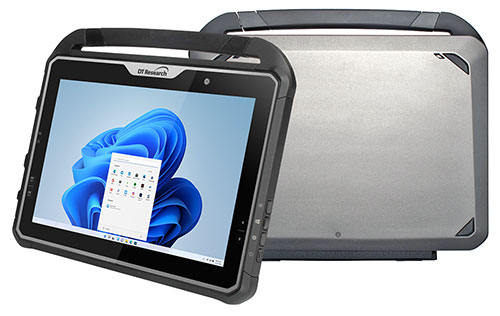 Measuring 10.71 x 7.70 x 0.79 inches and starting at less than three pounds, the DT302RP has a smaller standard battery than the DT301 (44.5 watt-hours vs 61.6 watt-hours), but customers can opt for an extended 61.6 watt-hour or 91.2 watt-hour battery if the job requires it. Local area network capability is at the AX210NGW level, which means Wi-Fi 6E that supports not just the common 2.4 and 5GHz bands, but also of the still largely untapped 6GHz band for speed and capacity. Optionally available are a 4G LTE/AWS mobile broadband module, a 1D/2D barcode scanner, dual-frequency RFID reader, Smart Card/CAC reader and dedicated ublox M9N GNSS. Also available are 5mp user-facing and 8mp documentation cameras (albeit not the Intel RealSense 3D camera available on the DT301 platform). Measuring 10.71 x 7.70 x 0.79 inches and starting at less than three pounds, the DT302RP has a smaller standard battery than the DT301 (44.5 watt-hours vs 61.6 watt-hours), but customers can opt for an extended 61.6 watt-hour or 91.2 watt-hour battery if the job requires it. Local area network capability is at the AX210NGW level, which means Wi-Fi 6E that supports not just the common 2.4 and 5GHz bands, but also of the still largely untapped 6GHz band for speed and capacity. Optionally available are a 4G LTE/AWS mobile broadband module, a 1D/2D barcode scanner, dual-frequency RFID reader, Smart Card/CAC reader and dedicated ublox M9N GNSS. Also available are 5mp user-facing and 8mp documentation cameras (albeit not the Intel RealSense 3D camera available on the DT301 platform).
The DT302RP's display is of the popular variety that measures ten inches diagonally, which makes for a light and handy tablet, and one with enough screen space for most work. It offers the same full-HD 1920 x 1200 pixel resolution as the company's DT301Y and the larger DT311H model. Like virtually all modern Windows tablets, the DT302RP has capacitive multi-touch, and DT Research also offers an active digitizer with a high-precision digital pen that needs a AAAA battery.
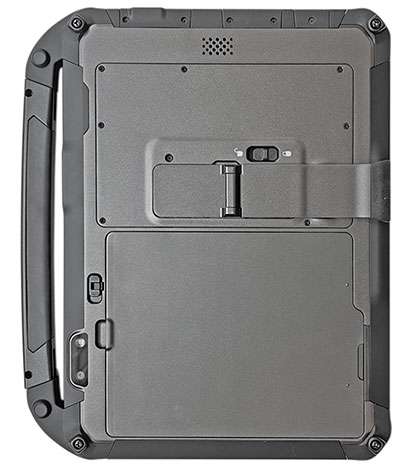 At RuggedPCReview.com, we examine the insides of review products whenever possible. Rugged devices are designed from the ground up to be rugged, and we seldom come across unpleasant surprises. But sometimes we do notice something that catches our attention and we may have follow-up questions and/or suggestions for the manufacturer. At RuggedPCReview.com, we examine the insides of review products whenever possible. Rugged devices are designed from the ground up to be rugged, and we seldom come across unpleasant surprises. But sometimes we do notice something that catches our attention and we may have follow-up questions and/or suggestions for the manufacturer.
The picture to the right shows the backside of the DT302RP, including the carry handle that can easily be installed or removed, but appears to come standard with the tablet.
The rectangle on the bottom is the battery. There is no battery compartment cover; the battery fits flush into the backside of the tablet, and it is its own cover. The battery is very slender, just 5/16th of an inch thick. There's a spring-loaded battery compartment slider with a lock. The battery easily slicks into place and is unlikely to ever come loose unintentionally.
The proprietary 11.4 Volt, 3800mAh lithium-ion polymer design with its 43.32 watt-hours is on the small side for a powerful Windows tablet — a decision DT Research made to make the tablet as sleek and light as possible. And, as stated above, if more is needed, there are optional extended batteries with more capacity,
Above the battery compartment is a cleverly designed removable access cover that also includes a flip-out kickstand. As pretty much every tablet user knows, having such a stand comes in extremely handy if you want to use a tablet on a desk or table.
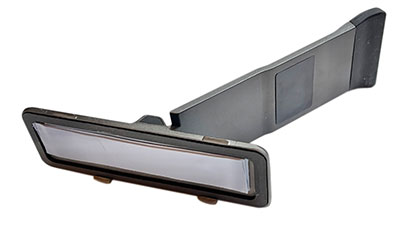 That kickstand doubles as a quick-release cover for the tablet's solid state storage module. Not everyone may need quick-release, but for some customers it's mandatory. This quick-release easel has thermally conductive material inside, which keeps the storage module from overheating. That kickstand doubles as a quick-release cover for the tablet's solid state storage module. Not everyone may need quick-release, but for some customers it's mandatory. This quick-release easel has thermally conductive material inside, which keeps the storage module from overheating.
The removable access cover itself is secured with eight screws; nine if you count the one that disables the SSD quick release. When would you need to take that cover off? Really only to insert or remove a nano-SIM card or an M.2 4G LTE/AWS mobile broadband module.
Taking the DT302RP tablet apart takes a bit of time. You start with removing the corner rubber bumpers, all the plastic antenna covers, and the protective I/O covers. That's not very difficult, but means undoing a good number and variety of small screws and bolts. Once all of those are taken care of (make sure you keep track of all the many parts and screws!), the two halves of the DT302RP come apart fairly easily. Caution is required though as there are four cables (power, speaker, sensor, cameras) that must be disconnected before the two halves fully separate.
The overall construction of the DT302RP then reveals itself. Pretty much the entire tablet, both front and back, is solid magnesium-aluminum alloy. Solid as in beefy and heavily reinforced, not the fragile lightweight kind sometimes found in consumer tablets. Below you can see the two structural halves of the DT302RP tablet, frontside on the left and backside on the right.
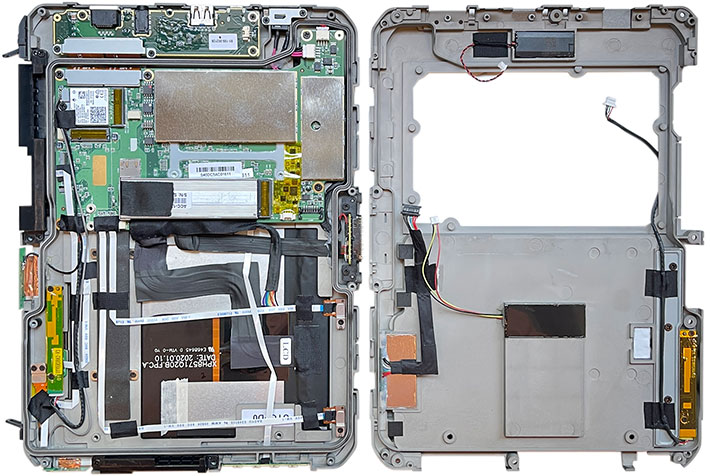
Sealing between the two magnesium-aluminum alloy halves is via a complex 3D tongue-and-groove design that goes around the perimeter. In the groove sits a replaceable rubber seal.
All major components are mounted on the two sides of the magnesium front half of the tablet, display on one side and electronics on the other. The motherboard measures about 6.5 x 3.5 inches. It's clearly a custom design for this particular tablet, cut and contoured to fit precisely into its space inside the metal frame.
Inside most rugged tablets and laptops you see prominent lengths of copper heat tubing that guide heat away from the hot electronics and to the fan. You don't see any of that in the DT302RP. That's because, like the DT301Y, the DT301RP is a fanless design, even with its powerful Intel "Raptor Lake" processors. All three available chips have a TDP (Thermal Design Power) of 15/55 watts, which means there is quite a bit of heat to dissipate. Doing that without a fan requires advanced thermal design but has several advantages. No fan means no fan noise, higher durability, no potentially undesirable air recirculation, and no mechanical component that can get clogged or fail. The pictures below were taken with a BlackView BL9000 Pro rugged handheld that's equipped with a FLIR Lepton thermal camera while the DT302RP was running a strenuous PCMark 10 performance test benchmark.
The bright yellow areas are the hottest, the orange and red areas cooler. What's amazing here is that even when running that demanding performance benchmark, the warmest area on the outside of the tablet reached barely more than 90F. That's remarkable for a passively cooled system without a fan. Things can get hotter outside on a hot day, or during prolonged heavy use, but the thermal design seems up to the task.
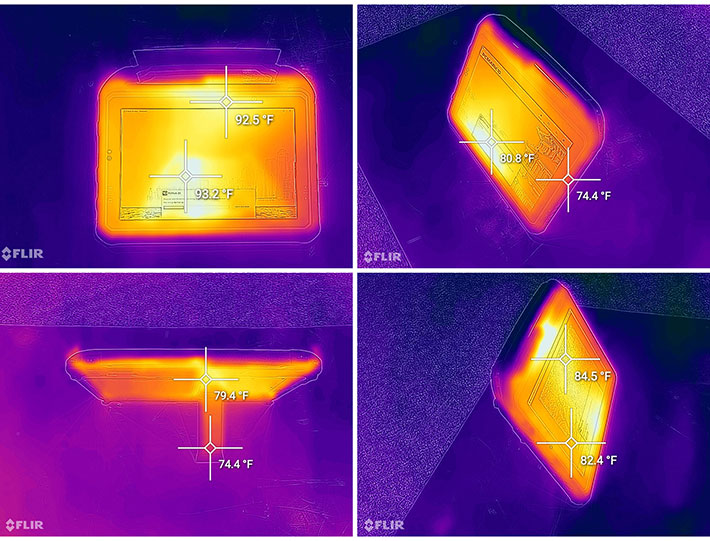
All of the DT302RP's I/O — USB 3.0, USB Type-C, an audio jack, and power — is mounted on a daughterboard that, like the various antennae, is located outside of the fully sealed metallic inner part of the tablet. The antennae are placed that way because they can't work inside a full metal enclosure. And placing all I/O on a daughterboard makes that board replaceable and customizable. As is usually the case, parts of the motherboard and other electronics are covered with metal shielding.
The overall layout is clean and logical, but there are a good number of ribbon cables going this way and that. This is certainly not a generic one-size-fits-all design. Sealing a rugged device of this complexity isn't easy, not with four different radio antennae that all must be outside the actual interior enclosure. To still reach IP65 ingress protection against dust and liquids is quite an achievement.
13th generation "Raptor Lake" hybrid processors
Right when we were in the midst of reviewing the DT Research DT301Y tablet earlier in 2024, the company launched the new DT302RP in the same size class but with newer technology. Initially we thought that made the review of the earlier model somewhat redundant, but DT Research informed us that they view the two as distinct and complementary models. The DT301Y would go on and continue to get upgrades, since it is one of their most popular products and it has options that the DT302RP doesn't have, such as UHF RFID and discrete GNSS.
One big difference is that the new DT302RP uses Intel 13th generation Core processor technology, two generations newer than the DT301Y's 11th gen processor lineup. What has changed?
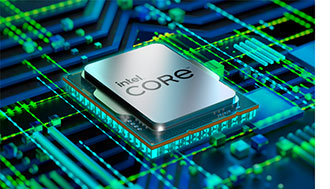 For many years, Intel's high-end Core-brand CPUs consisted of multiple processing cores of the same kind. That meant that all work was handled by those powerful cores, even if all that punch wasn't really needed for simple tasks. For many years, Intel's high-end Core-brand CPUs consisted of multiple processing cores of the same kind. That meant that all work was handled by those powerful cores, even if all that punch wasn't really needed for simple tasks.
With the "Alder Lake" 12th generation of their Core processors, however, Intel introduced a "hybrid" processor architecture that combined large, powerful performance cores ("p-cores") and smaller, simpler economy cores ("e-cores") in one chip. They did that because it doesn't make sense to use high-performance cores for all the simple routine or background work that goes on in a computer chip. For that same reason, smartphones have been using different, specialized cores for different work for years.
So in 12th gen "Alder Lake," p-cores handled the heavy lifting, and e-cores — basically using much simpler Intel Atom processor technology — handled all the simple routing work, with a "thread director" analyzing workload and sending tasks to the proper type of core.
|
|
Available CPUs
|
Intel U-series
|
Intel Core i5
|
Intel Core i7
|
|
|
Model
|
U300
|
1335U
|
1355U
|
|
|
Model gen/code
|
13th (Raptor Lake)
|
13th (Raptor Lake)
|
13th (Raptor Lake)
|
|
|
Performance cores
|
1
|
2
|
2
|
|
|
Efficient cores
|
4
|
8
|
8
|
|
|
Total threads
|
6
|
12
|
12
|
|
|
Max turbo P-cores
|
4.40 GHz
|
4.60 GHz
|
5.00 GHz
|
|
|
Max turbo E-cores
|
3.30 GHz
|
3.40 GHz
|
3.70 GHz
|
|
|
TDP
|
15/55 watts
|
15/55 watts
|
15/55 watts
|
|
|
Smart Cache
|
8MB
|
12MB
|
12MB
|
|
|
Integrated graphics
|
Intel Graphics
|
Iris Xe Graphics
|
Iris Xe Graphics
|
|
|
Graphics max speed
|
1.10 GHz
|
1.25 GHz
|
1.30 GHz
|
|
|
Graphics EUs
|
48
|
80
|
96
|
|
|
Intel vPro
|
NA
|
Essentials
|
Essentials
|
But time never stands still in the rapidly advancing world of computer processor design. In the "Raptor Lake" 13th generation, Intel improved and enhanced that hybrid processor architecture by increasing the core count, expanding L2 cache memory, raising clock speed, supporting faster DDR5 memory, as well as various fine-tunings and enhancements. Raptor Lake is like Intel hybrid chips 2.0 — evolved and refined. And that's what's in the DT302RP.
DT Research offers three processor options for the DT302RP. All three are 13th generation Raptor Lake designs, but for once there is a fairly large performance difference between the low-end and the two high-end CPU options. The low-end Intel Processor U300 has half the number of performance and efficient cores than the top two, half the Smart Cache, and Intel UHD Graphics with fewer execution units instead of the more advanced Intel Iris Xe graphics. Intel considers the U300 an entry-level chip as opposed to a mid-range mobile CPU like the other two. So keep that in mind when deciding which best fits your needs.
To provide an idea of where the DT302RP with its Intel 13th generation Core top-end i7-1355U chip stands in terms of performance, we ran it through all of our benchmark suites (PassMark 6.1 and PassMark 9, CrystalMark, PCMark 10, 3DMark, and GeekBench). For comparison we're also listing the results of the DT Research DT301Y and some of the mostly 10-inch competition's rugged tablets: Dell's Latitude 7030 and 7230 Rugged Extreme Tablet, the Getac UX10, Handheld's 10XR and the xTablet T1175 from MobileDemand. Here are the results:
|
DT Research DT302RP rugged tablet vs 10-inch class rugged tablets
|
|
Company
|
DT Research
|
DT Research
|
Dell
|
Dell
|
Getac
|
Handheld
|
Mobile Demand
|
|
Model
|
DT302RP
|
DT301Y
|
7030
|
7230
|
UX10
|
10XR
|
T1175
|
|
Year tested
|
2024
|
2024
|
2024
|
2023
|
2021
|
2023
|
2024
|
|
CPU Type
|
Intel Core
|
Intel Core
|
Intel Core
|
Intel Core
|
Intel Core
|
Intel Atom
|
Intel Core
|
|
CPU model
|
i7-1355U
|
i7-1165G7
|
i7-1260U
|
i5-1240U
|
i7-10510U
|
x6413E
|
i5-1335U
|
|
Display size
|
10.1-inch
|
10.1-inch
|
10.0-inch
|
12.0-inch
|
10.1-inch
|
10.1-inch
|
10.1-inch
|
|
Resolution (pixels)
|
1920 x 1200
|
1920 x 1200
|
1920 x 1200
|
1920 x 1080
|
1920 x 1200
|
1920 x 1200
|
1920 x 1200
|
|
Luminance
|
800 nits
|
1,000 nits
|
1,195 nits
|
1,337 nits
|
1004 nits
|
930 nits
|
688 nits
|
|
Footprint (inches)
|
10.71 x 7.70
|
11.00 x 7.80
|
10.36 x 7.40
|
11.65 x 8.00
|
10.8 x 7.5
|
11.1 x 7.1
|
11.54 x 7.56
|
|
Thickness (inches)
|
0.79
|
0.86
|
1.00
|
0.94
|
0.88
|
1.0
|
0.67
|
|
Volume (cu-in)
|
65.1
|
71.0
|
76.7
|
87.6
|
71.3
|
78.8
|
58.5
|
|
Weight as tested
|
3.00 lbs
|
3.10 lbs
|
2.24 lbs
|
2.76 lbs
|
2.68 lbs
|
2.70 lbs
|
2.73 lbs
|
|
Cooling
|
Fanless
|
Fanless
|
Fan
|
Fan
|
Fan
|
Fanless
|
Fan
|
|
Operating temp
|
14° to 140° F
|
14° to 140° F
|
-20° to 145° F
|
-20° to 145° F
|
-20° to 145° F
|
-4° to 140° F
|
-14° to 122° F
|
|
IP rating
|
IP65
|
IP65
|
IP65
|
IP65
|
IP65
|
IP65
|
IP65
|
|
PassMark 6.1
|
8,534
|
5,843
|
7,624
|
8,364
|
6,627
|
2,636
|
8,240
|
|
PassMark 9.0
|
5,391
|
4,787
|
5,607
|
5,516
|
3,869
|
1,917
|
5,067
|
|
CrystalMark
|
463,183
|
448,119
|
465,144
|
401,322
|
315,866
|
210,757
|
465,528
|
|
PCMark 10 Overall
|
5,235
|
4,837
|
5,052
|
4,847
|
3,869
|
2,344
|
4,801
|
|
PCMark 10 Disk
|
2,111
|
2,405
|
2,184
|
2,015
|
1,949
|
665
|
1,838
|
|
PCMark 10 Battery
|
5:43 hrs
|
9:31 hrs
|
8:16 hrs
|
11:51 hrs
|
NA
|
3:37 hrs
|
6:01 hrs
|
|
Watt-hour per hour
|
7.57
|
6.47
|
4.35
|
6.01
|
NA
|
7.77
|
10.64
|
|
3DMark TimeSpy
|
1,140
|
1,121
|
1,383
|
1,142
|
414
|
208
|
1,237
|
|
GeekBench 5 single
|
1,740
|
1,453
|
1,562
|
1,496
|
1,123
|
661
|
1,565
|
|
GeekBench 5 multi
|
5,362
|
3,843
|
7,001
|
7,049
|
2,839
|
1,899
|
4,810
|
|
GeekBench 5 Open CL
|
11,610
|
11,150
|
13,525
|
10,713
|
NA
|
2,104
|
12,377
|
The devices listed in the above table are all premium rugged tablet products that pack the performance level expected from their target markets. There is generally remarkable performance parity among the highest performance versions of each product line in that class. The tablets represent no fewer than four different Intel Core processor generation, and one tablet, the Handheld 10XR, relying on a lower performance Intel Atom processor that Handheld considers adequate for their market.
Given that its primary high-performance competition all use mechanical fans for cooling, the passive-cooled DT302RP provides astonishing performance. Fanless systems, which don't have the potential drawbacks of an active fan, are generally tuned more conservatively so as not to overheat in extreme conditions. DT Research really did an excellent job at performance-optimizing this tablet! Equally impressive is that they tuned the DT302RP so that its sustained performance on battery is the same as when the tablet is plugged in. That means no performance drop-off in the field.
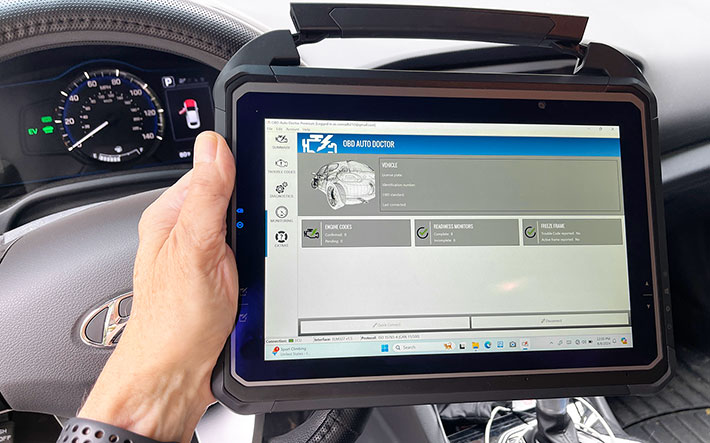
One additional interesting thing we noticed is that the DT302RP is one of the relatively few rugged tablets we've tested that does not show a performance drop-off when running on battery. Such drop-offs can be drastic in some systems that are tuned for maximum battery life instead of balanced performance. The DT302RP, on the other hand, actually ran many benchmark tests a bit faster on battery than when plugged in. The graph below shows how the CPU clock frequency of the DT302RP plugged in (left) and on battery (right) while running the PCMark 10 benchmark. According to this data, the system is tuned to hit its full 5.0GHz max turbo speed on battery, while maxing out at 4.5GHz when plugged in.

Battery life
Battery sizing is always a thorny issue for designers of mobile computers. That especially goes for tablets that should be as slim and light as possible because, unlike laptops, they are often carried around on the job. Even an extra half a pound for a bigger battery can make a noticeable difference if a tablet is carried around all day. With the DT302RP, DT Research decided to go for lowest possible weight, and that meant that standard battery with just 44.46 watt-hours. How long can the high-performance tablet with its bright display run on a charge of the small default battery?
To find out we used Passmark Software's BatteryMon benchmark utility to measure power draw under various operating conditions. With the Windows 11 Power setting set to "Best Power Efficiency" and the display backlight set to its lowest setting, we saw a minimum draw of about 4.3 watts. That's theoretically good for 10.3 hours.
|
DT Research DT302RP Power Draws (at idle)
|
|
Backlight level
|
Lowest (0%)
|
50%
|
Maximum (100%)
|
|
Max Battery
|
4.3 watts (10.3 hrs)
|
6.2 watts (7.2 hrs)
|
8.1 watts (5.5 hrs)
|
|
Max Performance
|
4.5 watts (9.9 hrs)
|
6.3 watts (7.1 hrs)
|
8.4 watts (5.3 hrs)
|
With the backlight set to roughly 50% for comfortable indoor viewing, we saw a minimum of 6.2 watts, theoretically good for 7.2 hours. And with the backlight set to maximum brightness, power draw rose to still modest 8.1 watts, theoretically good for 5.5 hours. We then switched the Windows 11 Power setting set to "Best performance." That way, with the display backlight set to its lowest setting, we saw only a higher minimum of about 4.5 watts. With the backlight set to 50% for comfortable indoor viewing, we recorded 6.3 watts, and with the backlight set to maximum brightness, power draw was 8.4 watts, barely more than in the economy setting, and theoretically good for 5.3 hours.
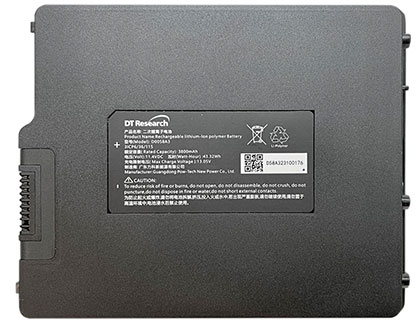 BatMon, of course, only measures battery draw at idle, which means it shows how long the system would run, always on, but just idling along. BatMon, of course, only measures battery draw at idle, which means it shows how long the system would run, always on, but just idling along.
A better measure of the tablet's battery life while being used is the PCMark 10 Battery test. This test continually exercises the system with a variety of typical office and field work, such as web browsing, wordprocessing, spreadsheets, graphics and more. In that test, the DT302RP ran for 5:43 hours, consuming 7.57 watt-hours per hour.
That means that in deployments where the tablet would be in continuous use, the DT302RP would need the optional 61.6 watt-hour (or better yet, the 91.2 watt-hour) extended battery to make it through a full shift.
Interestingly, the BatMon power draws we measured on the DT302RP were about 15% lower than those of the older DT301Y model with its Intel 11th generation quad-core i7-1165G7 processor. On the other hand, while the DT301Y with its larger 61.6 watt-hour battery lasted 9:31 hours in the PCMark 10 battery test, it consumed a slightly lower 6.47 watt-hours per hour than the new DT302RP.
Bright, excellent 10.1-inch full HD display
The DT302RP tablet's 10.1-inch display offers full HD 1920 x 1200 pixel resolution, making for a 16:10 aspect ratio and a sharp 224 pixels per inch. The display surface is of the glossy variety seen today on virtually all tablets and smartphones. Indoors, the DT302RP display is very pleasant to use and work on, and full brightness is never needed. Outside, as is the case with all current transmissive displays, viewability depends on lighting conditions, reflections, contrasts, viewing angles and more.
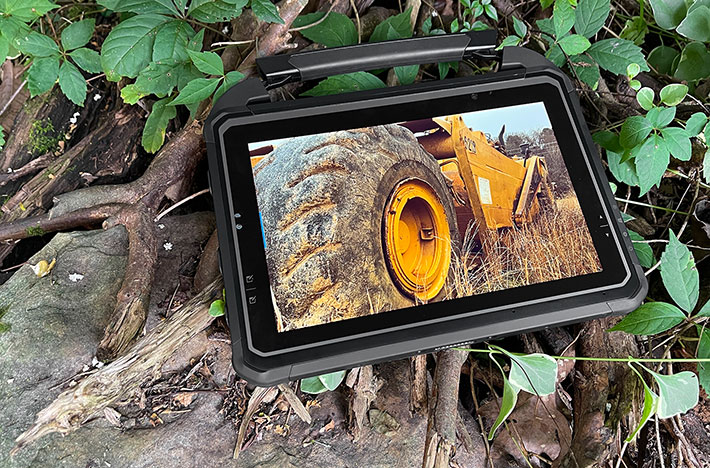
Not too long ago, outdoor viewability was the weak point of most rugged mobile computing devices. Display technologies — reflective, transflective, hybrids and others — came and went, none getting close to providing more than barely acceptable results. Eventually the industry decided that modifying conventional transmissive LCDs for daylight and sunlight use was the best currently available way to go.
That's done by reducing the display's internal reflection of ambient light so that, in conjunction with a reasonably strong backlight, there is enough contrast to make the screen viewable outdoors. This reduction of internal reflection is accomplished via a combination of polarizers, filters, coatings and elimination of air spaces between the various layers of the LCD.
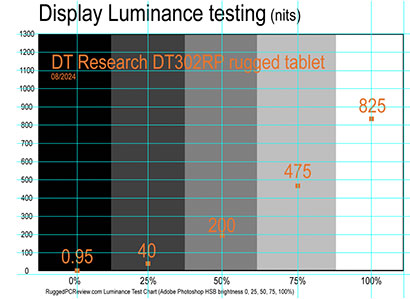 Almost all mobile devices use this technology today, but the exact implementation varies from manufacturer to manufacturer. As does the strength of the backlight (a stronger backlight means a larger battery or shorter battery life).
Almost all mobile devices use this technology today, but the exact implementation varies from manufacturer to manufacturer. As does the strength of the backlight (a stronger backlight means a larger battery or shorter battery life).
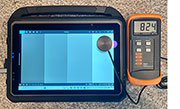 Backlight strength varies with the type of device. Desktop monitors and standard notebooks are usually in the 200 nits range. Modern smartphones and tablets are between 400 and 600 nits. Rugged laptops are available with as much as 1,500 nits. Cranking luminance up too high can make for a washed-out look and quickly drains batteries. So DT Research settled on 800 nits for the DT302RP, 20% less than the DT301Y's 1000 nits luminance. Backlight strength varies with the type of device. Desktop monitors and standard notebooks are usually in the 200 nits range. Modern smartphones and tablets are between 400 and 600 nits. Rugged laptops are available with as much as 1,500 nits. Cranking luminance up too high can make for a washed-out look and quickly drains batteries. So DT Research settled on 800 nits for the DT302RP, 20% less than the DT301Y's 1000 nits luminance.
The graph to the right shows how the tablet did in our luminance test. At full black we measured just 0.95 nits, at full white we saw as high as 825 nits, a bit more than the 800 nits spec.
The picture below shows the DT302RP outdoors on a bright day with the backlight cranked all the way up to 100%. Like all "glossy" displays, The DT302RP's shows reflections, that's just in the nature of the technology. What's unusual is the blue and purple cast of the reflection, likely as the result of some of the type of coatings (we noticed that on the DT301Y also).
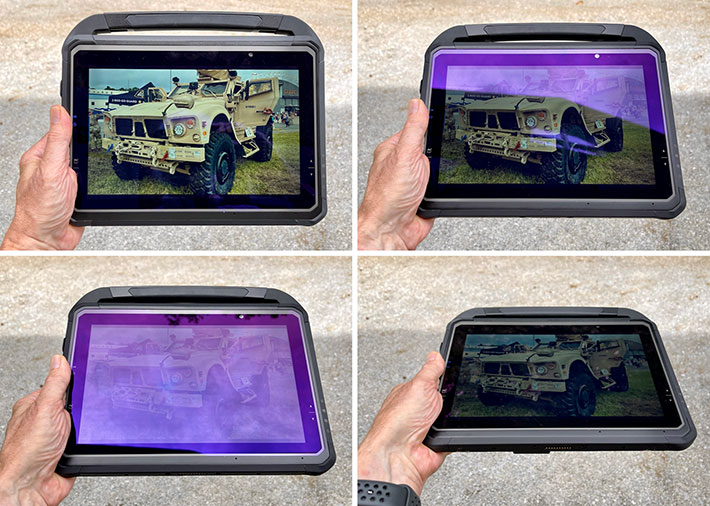
Overall, the display of the DT302RP works well and is pleasant to use. It's bright enough, it has near perfect viewing angles, there are no contrast and color shifts when viewing even from extreme angles, and reflection control is as good as it currently gets.
Optional camera modules
As is the case these days with all smartphones and almost all tablets, the DT302RP has integrated cameras. They are optional modules, but in this day and age of video conferencing, having at least a user-facing onboard camera is definitely a good thing.
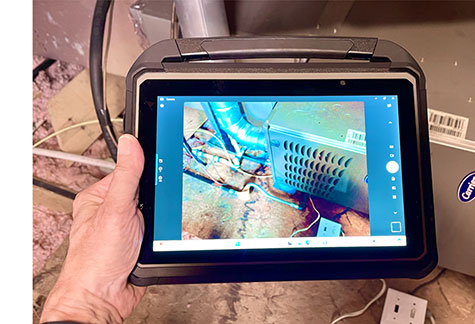 The front camera has a 5MP imager, the rear documentation camera 8MP, auto focus, white balance, gain control, and exposure control. One thing the DT302RP doesn't have, even as an option, is the DT301Y's innovative Intel RealSense Depth camera that supports distance capture for 3D scanning, environment sensing, and background segmentation applications. That's an emerging technology with significant application potential is limited only by imagination. Our review DT302RP came with both of the optional cameras. The front camera has a 5MP imager, the rear documentation camera 8MP, auto focus, white balance, gain control, and exposure control. One thing the DT302RP doesn't have, even as an option, is the DT301Y's innovative Intel RealSense Depth camera that supports distance capture for 3D scanning, environment sensing, and background segmentation applications. That's an emerging technology with significant application potential is limited only by imagination. Our review DT302RP came with both of the optional cameras.
The 8-megapixel camera and uses the Windows Camera app that records images at 3264 × 2448 pixel resolution.
Video defaults to 1920 x 1080 at 30 frames per second, but you can also switch to 2448p video in 4:3 format, which means the same 3264 × 2448 pixels as the fixed still resolution. That's actually close to the same pixel count as 4k video (3840 x 2160), only in a 4:3 aspect ratio instead of the common 16:9 wide format.
In still photography, auto-focus was a bit of a mystery, sometimes focusing as it should, other times seeming uncertain. Most PC cameras allow tapping on the subject you want to focus on, but that feature doesn't seem to be available here. Most, but not all, test images were reasonably to very sharp, the camera did not over-compress images, and operation was fairly quick. The same applied to video. What's missing is frame rates higher than 30 fps. Those come in handy for slow-motion.
The pictures below were taken with the DT302RP's camera in its highest 4:3 aspect ratio 3264 × 2448 pixel resolution (click on the sample pics for a full-size version of the entire picture compilation).

Almost everyone carries a smartphone in their purse or pocket these days, which means that integrated cameras are no longer as important as they once were. The 8mp camera in the DT302RP can come in handy; the limiting factor is the very marginal Windows camera app.
Light and handy, but also very rugged
There are hundreds of millions of tablets in use now, but most are consumer-grade designs that too fragile for field or even enterprise use. There are aftermarket cases for many of those, but they generally only add little protection. That's why there are rugged tablets like the DT302RP. The flipside is that ruggedness will increase size, weight and cost (though the latter may be offset by increased durability and service life). What matters is that makers of rugged tablets aim for the right balance. A good tablet for work in the field must be tough enough for the job, light and handy enough for easy use, but still affordable to fit the budget.
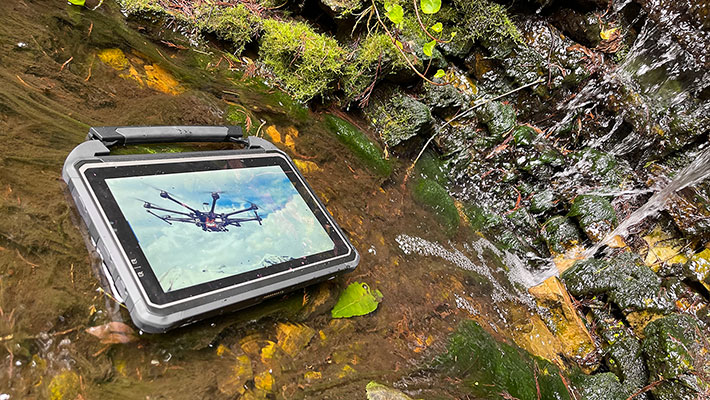
Thanks to its ABS+PC polycarbonate and magnesium-aluminum alloy construction, the DT302RP is inherently very solid. And according to DT Research, the DT302RP's entire enclosure has antimicrobial properties. That can be mandatory in medical and certain other vertical markets.
Ingress protection is at the IP65 level, which means the device is fully protected against dust, and also protected against low pressure water jets from all directions. IP65 is the norm for rugged tablets in this class. It allows using the tablet in the rain, it won't get damaged sitting in a puddle or being washed off. Do make sure, though, that the protective doors are closed when using the tablet in wet conditions.
The standard operating temperature range is a very wide -14 to 140 degrees, making the system deployable almost anywhere, including in commercial freezers. If even higher low temperature tolerance is required, there's a -22F option.
DT Research also claims MIL-STD-810H testing for drop, shock and vibration, as well as MIL-STD-461F certification for EMI and EMC tolerance. Here it would be good to see more detailed information in the spec sheet and promotional materials. Customers are interested in rugged tablets because they can handle more abuse, so specific information on just how much abuse should be included.
With its heavy-duty magnesium frame inside and the hefty integrated rubber corner guards outside, the DT302 platform can handle a good deal of punishment. The tablet feels very solid and there isn't any of the flex or creaking that's so prevalent in many consumer devices. That said, it would be good to know what sort of strengthened glass DT Research used and also what sort of scratch resistance the elegant metallic and plastic surfaces provide.
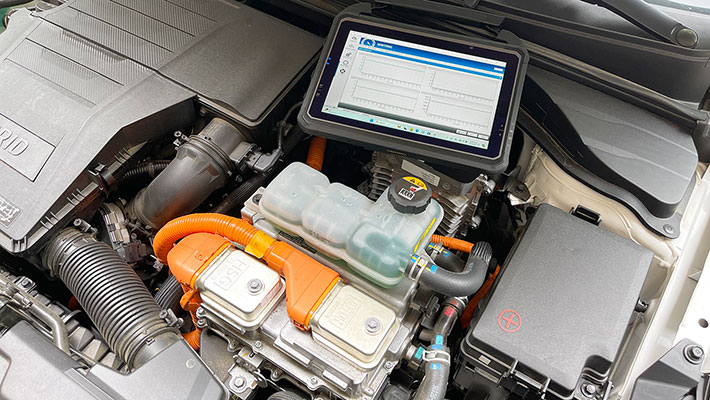
Summary: DT Research DT302RP rugged tablet computer
With the DT302RP, DT Research provides a slim, lightweight modern rugged tablet and 2-in-1 tablet/laptop computer that's tough enough for use in health care and a wide range of other vertical markets that need a higher level of durability and resistance to harsh environmental conditions than consumer tablets offer, even if they are in a case.
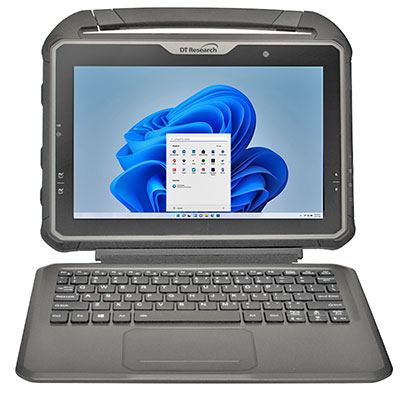 Powered by high-performance Intel 13th generation processors, the DT302RP has a bright, daylight-viewable 10.1-inch capacitive multi-touch display with full 1920 x 1200 HD resolution, perfect viewing angles from all directions, and an optional active pen with a pencil-thin, pressure-sensitive tip. Powered by high-performance Intel 13th generation processors, the DT302RP has a bright, daylight-viewable 10.1-inch capacitive multi-touch display with full 1920 x 1200 HD resolution, perfect viewing angles from all directions, and an optional active pen with a pencil-thin, pressure-sensitive tip.
Weighing just under three pounds, the nicely designed ABS + PC plastic tablet with a strong magnesium-alloy core is tough and well protected.
Equipped with a full-size USB 3.0 Type-A and a reversible USB Type-C port, 3.5mm audio jack, and an RJ45 LAN jack, the DT302RP can be custom configured with a 8mp rear camera, a user-facing 5mp vidcam, 1D/2D barcode scanning, mobile broadband, as well as discrete U-blox M9N GNSS.
The optional magnetically detachable keyboard converts the DT302RP into a hybrid 2-in-1 device that can instantly provide full laptop functionality without the extra bulk and weight of a permanently attached keyboard.
All of this combines into a modern, state-of-the-art Windows 10/11 IoT Enterprise 2-in-1 tablet hybrid solution with the performance required for even the most demanding field applications. -- Conrad H. Blickenstorfer, August 2024
|
DT Research DT302RP Specifications
|
| Status |
Full review DT302RP 07/2024
|
| Type |
Rugged Mobile 2-in-1 Windows tablet
|
| Processor Cores |
Intel "Raptor Lake" Core i7-1355U: 2 Performance, 8 Efficient
Intel "Raptor Lake" Core i5-1335U: 2 Performance, 8 Efficient or
Intel "Raptor Lake" Processor U300: 1 Performance, 4 Efficient
|
| CPU Max Turbo |
Intel Core i7-1355U: 5.00GHz
Intel Core i5-1335U: 4.60GHz
Intel Processor U300: 4.40GHz
|
| TDP |
All 12/55 watts
|
| Graphics |
Intel Core i7-1355U: Intel Iris Xe
Intel Core i5-1335U: Intel Iris Xe
Intel Processor U300: Intel UHD for 13th gen
|
| Graphics EUs |
Intel Core i7-1355U: 96
Intel Core i5-1335U: 80
Intel Processor U300: 48
|
| OS |
Microsoft Windows 10/11 IoT Enterprise
|
| Memory |
8GB to 32GB
|
| Storage |
64GB to 2TB PCIe nVME SSD
|
| Display |
Outdoor-viewable TFT with LED backlight, 800 nits luminance, anti-reflection coating |
| Display Size/Resolution |
10.1-inch/1920 x 1200 pixel FHD (224 ppi) |
| Digitizer |
Capacitive multi-touch, optional active digitizer/pen with replaceable 1.5mm tip (uses AAAA battery) |
| Keyboard |
Optional detachable keyboard available |
| Navigation |
Stylus, touch |
| Expansion slots |
Est: NA |
| Housing |
ABS + PC plastics, magnesium-aluminum alloy structure/frame, anti-microbial coating
|
| Size |
10.71 x 7.70 x 0.79 inches (272 x 196 x 20 mm) |
| Weight |
3.0 lbs. (1.32kg) |
| Operating temperature |
-14° to 140°F (optional -22° to 140°F)
|
| Ingress protection |
IP65 |
| Altitude |
unknown
|
| Drop/shock |
MIL-STD-810H (4-foot drop) |
| Vibration |
MIL-STD-810H |
| Regulatory |
FCC Class B, CE, RoHS compliant |
| EMC |
MIL-STD-461F |
| Power |
Hot-swappable 11.4V 3,900 mAH Li-Ion (44.46 watt-hours); optional hot-swappable 11.4V 5,400 mAH Li-Ion (61.6 watt-hours) or 11.4V 8,000 mAH Li-Ion (91.2 watt-hours)
|
| Cameras |
Optional: front-facing 5mp camera, rear-facing 8mp back AF camera with LED flash
|
| Data capture |
Optional: 1D/2D barcode scanner, HF/RFID 13.56MHz reader
|
| Sensors |
Accelerometer
|
| Interface |
1 x USB 3.0, 1 x USB Type-C, 1 x RJ45 LAN, 1 x 3.5mm audio in/out, power
|
| Wireless options |
Intel Dual Band Wi-Fi 802.11ax, 2.4GHz/5GHz/6GHz dual band, Bluetooth v5.2 (optional Class 1 (1,000 feet) BT available), optional: 4G LTE/AWS; ublox M9N GNSS module
|
| Price |
Inquire |
| Product page |
DT302RP web page |
| Spec sheet |
 DT302RTP datasheet (PDF) DT302RTP datasheet (PDF)
|
| Warranty |
1, 2, or 3 year extended or no-fault options
|
|
Contact
|
DT Research
2000 Concourse Drive
San Jose, CA 95131, USA
Tel: (408) 934-6220
Fax: (408) 934-6222
Web: www.dtresearch.com
|
(copyright 2024 RuggedPCReview.com)
|
|
|






